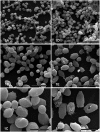Antimicrobial activity of Buchenavia tetraphylla against Candida albicans strains isolated from vaginal secretions
- PMID: 28376640
- PMCID: PMC7011787
- DOI: 10.1080/13880209.2017.1304427
Antimicrobial activity of Buchenavia tetraphylla against Candida albicans strains isolated from vaginal secretions
Abstract
Context: Buchenavia tetraphylla (Aubl.) RA Howard (Combretaceae: Combretoideae) is an ethnomedicinal plant with reported antifungal action.
Objective: This study evaluates the antimicrobial activity of B. tetraphylla leaf extracts against clinical isolates of Candida albicans. The morphological alterations, combinatory effects with fluconazole and the cytotoxicity of the active extract were analyzed.
Materials and methods: Extracts were obtained using different solvents (hexane: BTHE; chloroform: BTCE; ethyl acetate: BTEE; and methanol: BTME). Antimicrobial activity was determined by the broth microdilution method using nine strains of C. albicans isolated from vaginal secretions and one standard strain (UFPEDA 1007).
Results: All extracts showed anti-C. albicans activity, including against the azole-resistant strains. The MIC values ranged from 156 to 2500 μg/mL for the BTHE; 156 to 1250 μg/mL for the BTCE; 625 to 1250 μg/mL for the BTME and 625 μg/mL to 2500 μg/mL for the BTEE. BTME showed the best anti-C. albicans activity. This extract demonstrated additive/synergistic interactions with fluconazole. Scanning electron microscopy analysis suggested that the BTME interferes with the cell division and development of C. albicans. BTME showed IC50 values of 981 and 3935 μg/mL, against J774 macrophages and human erythrocytes, respectively. This extract also enhanced the production of nitric oxide by J774 macrophages.
Discussion and conclusion: Buchenavia tetraphylla methanolic extract (BTME) is a great source of antimicrobial compounds that are able to enhance the action of fluconazole against different C. albicans strains; this action seems related to inhibition of cell division.
Keywords: Antifungal agents; Caatinga biome; natural products.
Figures



Similar articles
-
Antifungal activity of extracts and isolated compounds from Buchenavia tomentosa on Candida albicans and non-albicans.Future Microbiol. 2015;10(6):917-27. doi: 10.2217/fmb.15.20. Future Microbiol. 2015. PMID: 26059616
-
Antifungal potential of Sideroxylon obtusifolium and Syzygium cumini and their mode of action against Candida albicans.Pharm Biol. 2016 Oct;54(10):2312-9. doi: 10.3109/13880209.2016.1155629. Epub 2016 Mar 17. Pharm Biol. 2016. PMID: 26987037
-
Antifungal effect of Echinophora platyloba on expression of CDR1 and CDR2 genes in fluconazole-resistant Candida albicans.Br J Biomed Sci. 2016;73(1):44-8. doi: 10.1080/09674845.2016.1155269. Br J Biomed Sci. 2016. PMID: 27182677
-
Bioactive triterpenoids from Solanum torvum fruits with antifungal, resistance modulatory and anti-biofilm formation activities against fluconazole-resistant candida albicans strains.PLoS One. 2021 Dec 28;16(12):e0260956. doi: 10.1371/journal.pone.0260956. eCollection 2021. PLoS One. 2021. PMID: 34962953 Free PMC article.
-
Herbal Extracts with Antifungal Activity against Candida albicans: A Systematic Review.Mini Rev Med Chem. 2021;21(1):90-117. doi: 10.2174/1389557520666200628032116. Mini Rev Med Chem. 2021. PMID: 32600229
Cited by
-
Antifungal effect of the effect of Securigera securidaca L. vaginal gel on Candida species.Curr Med Mycol. 2019 Sep;5(3):31-35. doi: 10.18502/cmm.5.3.1744. Curr Med Mycol. 2019. PMID: 31850394 Free PMC article.
-
Candida Infections and Therapeutic Strategies: Mechanisms of Action for Traditional and Alternative Agents.Front Microbiol. 2018 Jul 3;9:1351. doi: 10.3389/fmicb.2018.01351. eCollection 2018. Front Microbiol. 2018. PMID: 30018595 Free PMC article. Review.
-
Antifungal and antibiofilm effects of probiotic Lactobacillus salivarius, zinc nanoparticles, and zinc nanocomposites against Candida albicans from Nile tilapia (Oreochromis niloticus), water and humans.Front Cell Infect Microbiol. 2024 Jun 4;14:1358270. doi: 10.3389/fcimb.2024.1358270. eCollection 2024. Front Cell Infect Microbiol. 2024. PMID: 38895734 Free PMC article.
-
Himatanthus drasticus Leaves: Chemical Characterization and Evaluation of Their Antimicrobial, Antibiofilm, Antiproliferative Activities.Molecules. 2017 May 31;22(6):910. doi: 10.3390/molecules22060910. Molecules. 2017. PMID: 28561790 Free PMC article.
-
Products Derived from Buchenavia tetraphylla Leaves Have In Vitro Antioxidant Activity and Protect Tenebrio molitor Larvae against Escherichia coli-Induced Injury.Pharmaceuticals (Basel). 2020 Mar 16;13(3):46. doi: 10.3390/ph13030046. Pharmaceuticals (Basel). 2020. PMID: 32188166 Free PMC article.
References
-
- Agra MF, Baracho GS, Silva KN, Basílio IJLD, Coelho VPM.. 2007. Medicinal and poisonous diversity of the flora of Cariri Paraibano, Brazil. J Ethnopharmacol. 111:383–395. - PubMed
-
- Agra MF, Silva KN, Basílio IJLD Freitas PF, Barbosa-Filho JM.. 2008. Survey of medicinal plants used in the region northeast of Brazil. Braz J Pharmacog. 18:472–508.
-
- Avijgan M, Mahboubi M, Nasab MM, Nia EA, Yousefi H.. 2014. Synergistic activity between Echinophora platyloba DC ethanolic extract and azole drugs against clinical isolates of Candida albicans from women suffering chronic recurrent vaginitis. J Mycol Med. 24:112–116. - PubMed
-
- Berman J, Sudbery PE.. 2002. Candida albicans: a molecular revolution built on lessons from budding yeast. Nat Rev Genet. 3:918–932. - PubMed
-
- Blanco MT, Sacristán B, Lucio L, Blanco J, Pérez-Giraldo C, Gómez-García AC.. 2009. Cell surface hydrophobicity as an indicator of other virulence factors in Candida albicans. Rev Iberoam Micol. 27:195–199. - PubMed
MeSH terms
Substances
LinkOut - more resources
Full Text Sources
Other Literature Sources
